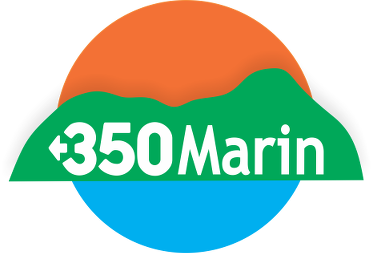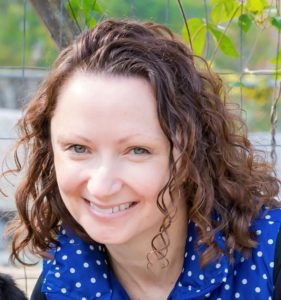
Conservation Corps North Bay is a 40 year old organization focused equal parts on the environment, and community. Just last year the organization restored and maintained 148 miles of Bay Area Trails, and diverted 506,756 pounds of e-waste from the landfill. 350Marin sat down Anastasia for an interview about the essence of her organization, and how it’s developed into what it is today.
Conservation Corps. North Bay (CCNB) has been around for 40 years. How has it changed?
In so many different ways. When we first started back in 1982, our founder was a Marin resident, Rich Hammond. He had already been very much involved in the natural resources world at the state level. And in 82’, there were significant storms that happened in Marin. The cycle that has been accelerated because of climate change, of drought and deluges of rain, was shorter back then. So in 82’ there were major floods after a couple of years of drought that just flooded all sorts of parts of Marin. I grew up just over the hill, in Marinwood, and I have memories of people in their kayaks on the flat streets because it was that flooded. That same storm also washed out a lot of the trails on Mount Tam where Rich ran. He noticed how long it was taking for all those trails to be repaired and restored after those storms. And he thought, we need to do something about this. At the same time, he had some teenage sons that could make good use of their time on a new project. So out of that, the idea was born.
We started in 82’ with just a couple of projects working on Mount Tam, like Bootjack trail was one of them and a couple of other trails that the first 16 Corps members worked on. Back then, the goal of the program was basically service to the community through environmental projects. Then shortly thereafter an educational component came on. Where it’s evolved over time is the addition of the zero waste program. So the recycling services. That came on in 1989 when we started doing bottles and cans collection in Marin County parks, which we still do to this day. Services evolved from there into adding the school component a couple of years later.
Because we’re certified by the state as a local nonprofit conservation corps, we have some benefits that we can offer to young people. For example the ability to complete a high school diploma when you’ve aged out of the traditional high school system. We serve ages 18 to 30, and normally once you turn 18, you can’t complete your high school diploma at a public school. You have to get your GED or move on in another way. But because of our certification, we’re able to offer that full four year diploma to members in our program who haven’t completed high school. We do it through the John Muir Charter School, which is a charter school program that specializes in adult education, so for folks over 18 that haven’t completed high school. And then over time, we evolved even more to provide career coaching on top of everything else. So really evolving into a job training program where the hands on work experience and the education were two great components. But as it evolved into a job training program, we found that young people can also use guidance and career exploration workshops and soft skills training and help writing a resume. All those different things that we’ve now added to our program to complete the whole package.
When we first started, we were actually Marin Conservation Corps. So you might still hear some of the really old school environmentalists in Marin refer to us as MCC. When we expanded to Sonoma County in 2008, that was when we became Conservation Corps North Bay. We had been here for a couple decades getting the program stable and growing on its own, and then we saw that there was a really similar need in Sonoma County, both from a youth development standpoint and an environmental work standpoint. And so we expanded services up there and then changed our name.
We continue to evolve. Now, in our 40th year, we are looking at different types of career paths for young people. So corpsmembers who join our program, as I just described it, by the time they finish, are ready to gain entry level employment at places like Marin County Parks or Marin Water or other government agencies or even landscaping companies where they can use the skills that they’ve learned here. But we have also been thinking, what about folks who want to have a more specialized career, like in the fire service or something more intensive, like ecological restoration work? We’re now working on formulating these accelerated career paths for folks that want to continue their training and eventually start a higher level career as well. So we continue to grow in our 40th year.
How has CCNB stayed the same?
The youth is really the common thread. Making sure that local young people have skills to gain living wage employment in their own communities, which can be really hard to do, especially in Marin County, given the cost of living here. But also the community resources that we provide through the paid work experience that corpsmembers gain with us through fire fuel reduction, and flood prevention work. Crews work in creeks a lot, especially during the summer to clear out vegetation, and even doing a lot of work keeping recyclable material out of the landfill, it all ends up out of benefiting the community.
It seems like Conservation Corps is focused equal parts on environment and community. How do they complement each other?
In a couple of different ways. We’re not only protecting our neighbors from the effects of climate change, whether it’s from fire or flood. We’ve also done a lot of lawn conversion projects with Marin Water at the onset of this version of the drought. A couple of years ago, we partnered with Marin Water and converted 40 different lawns in Marin. They had a rebate for their customers to tear out their lawns and their sprinkler systems to save water and then put in water-wise landscaping. They trained our crews to do all that, taking all the grass out and even laying the foundation for drip irrigation that is recommended by Marin water. So lots of benefits just around trying to protect our communities from the effects of climate change. We’re struggling to be on the prevention side of it because it’s more of a global challenge and the big companies are really the ones who are going to need to step up to work on the prevention side.

Another spot where we do that is through our zero waste program. Keeping valuable material out of the landfill so they aren’t just sitting there for hundreds of years and not breaking down. So bottles and cans, e-waste, mattresses are pretty new for us over the last couple of years. You might not know this, but when you buy a mattress, you pay a fee that goes toward recycling it responsibly. There’s an organization called the Mattress Recycling Council that is in charge of collecting that fee and using that money to get all these used mattresses. So we’re a collector of those both here at our Novato location and in Cotati. And then theyget torn apart into all the different components and then are repurposed into a number of different items. So that is the shout out for bringing your mattress here when you’re ready to swap it out.
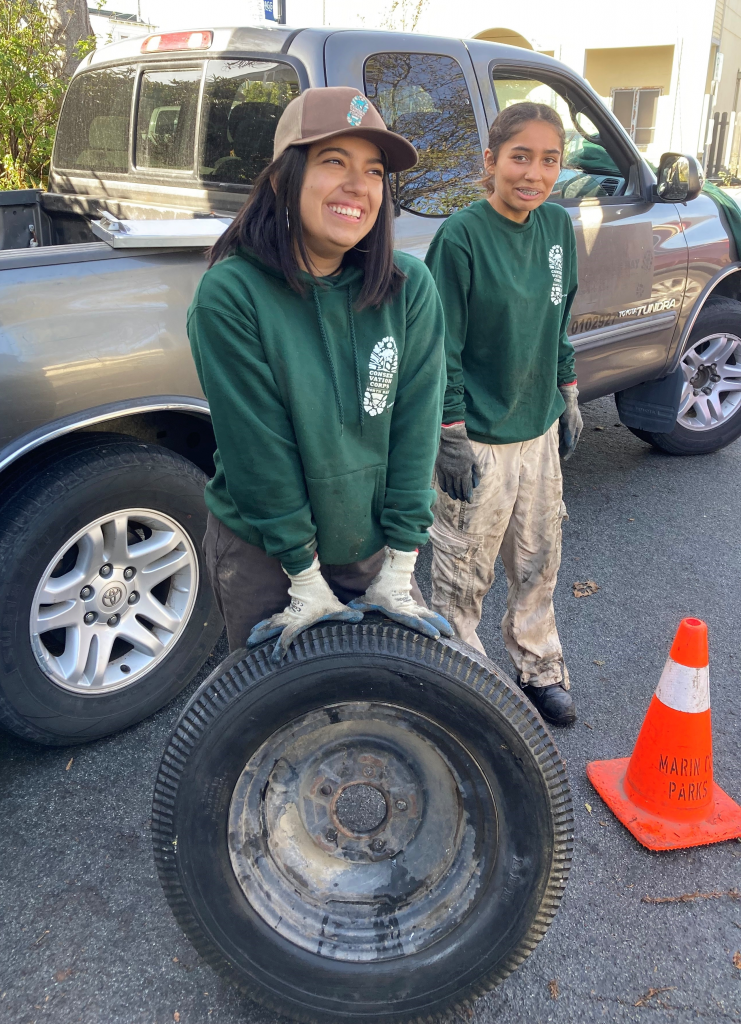
Same for tires. Tires pose a lot of different problems. Not only do they not break down, but if they’re tossed in creeks or public or private land that is near our waterways, they can contaminate the creeks and the rivers and on into the ocean. So it’s a much bigger problem than just litter. And they also can be repurposed. So we collect those as well. Our roof here is actually made out of recycled tire material, as is the pathway in our front yard that you just walked through. So in all those ways, we help our communities protect their homes and their health as much as possible from the effects of climate change.
The latest thing that our zero waste team has started working on is food recovery. There was legislation that passed in the state that food generators, over a number of years, are slowly supposed to start working toward diverting edible food or any kind of organics from the landfill. So starting from manufacturers to farmers all the way down to local restaurants, over the course of a few years. Everyone will be required to either compost food waste or, if it’s edible, get it to folks who are experiencing hunger. And our team is getting involved in that, more frequently in Sonoma County. Now you’re seeing organizations like Extra Food, who we partner, starting to really step up communications around having folks be sure that they’re composting. That goes all the way down to the consumer. A lot of the hauling organizations like Marin Sanitary and Recology have started at the individual level, making sure that residents are composting first. That’s one way that we benefit the community. Another is training local young people for jobs that we know are already available and hard to fill. Jobs in government agencies or municipalities. A lot of that workforce is older and retiring. They’re calling it the “Silver Tsunami”, where a lot of public employees are retiring in large numbers because of when they first started. And there’s a serious need to fill skilled folks into those positions, and there are only going to be more positions like that going on into the future. Especially as climate change continues to affect everything that’s happening environmentally in our community. So we help residents, we help organizations hire, and we help young people who’ve been experiencing significant barriers to financial independence navigate those barriers like finishing high school, learning English, getting hands on training certifications so that they can be financially independent as well. So there are lots of different benefits to the program.
Tell me about the Natural Resources Crew.
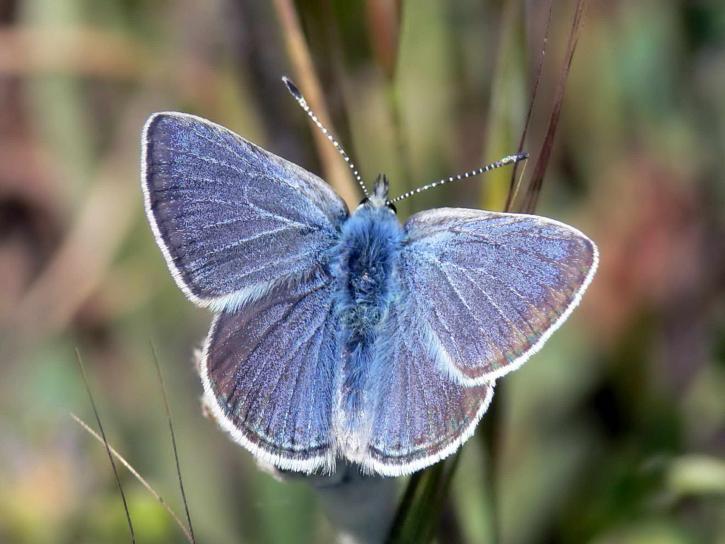
It’s manyfold. Most of our corpsmembers are on the natural resources side. We have partners both in Marin and Sonoma counties that hire corpsmembers to do projects that are already planned and for those agencies. The coolest things that we do are things like trail work in county parks or in the GGNRA (Golden Gate National Recreation Area) and working with the National Park Service on habitat restoration. We’ve done some really cool projects like out of Fort Baker, planting lupine. Lupine is the flower that the Mission Blue Butterfly thrives on.
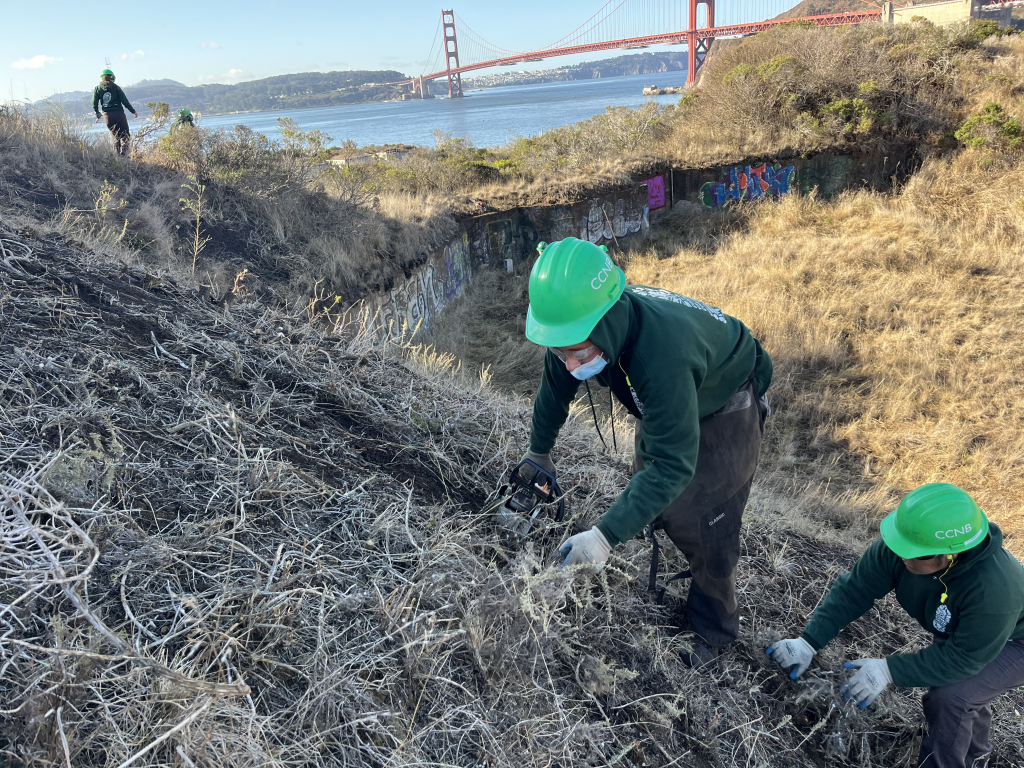
And so we’ve been working on removing invasive species and planting the lupine so that the mission blue butterfly can thrive. Even out here in Hamilton, in the wetlands, we’ve been doing a lot of restoration as well. So those are some of the cooler projects that we work on. And then day to day it can be things like the standard fire fuel reduction and creek clearing which, over time, can get kind of mechanical if you don’t see the whole picture of how it’s helping prevent the effects of these natural disasters. But a big part of the work that we do is reducing fire fuels. And there are more resources from the government now to do that, especially after what happened in Sonoma County dating back to 2017. There’s a lot of money that’s gone in through property tax initiatives, especially in Marin. Measure C was passed by the voters to say, “yes, please, tax us through a property tax to fund this Marin Fire protection authority.” So there are resources out there both for government agencies, the fire departments, and all the different neighborhoods to create defensible space through vegetation management. There’s even money for individuals too in the form of grants either if they can’t afford to do the work themselves or they can’t physically do it themselves. Individuals can get grants to pay other folks to do that. And then there’s the super fun, corpsmembers might laugh if we call it super fun, but just pulling invasives like Scotch Broom, and all the different kinds of invasive plants that both disrupt the ecosystem and contribute to fire risk. They are most effectively eliminated by pulling and so not using a weed whacker or anything like that because that just spreads seeds. So hand pulling broom is probably the least exciting thing that they do, but is very important.
How about the zero waste crew?
So they’re small but mighty. Funding sources have a lot to do with the type of work that we do. A lot of it depends on where the money comes from for government agencies to hire, because they essentially hire our crews to do this work. And that’s what provides the paid job training piece of the program for the young people. The Zero Waste team historically was funded by a significant grant that we still get every year from Cal Recycle, and that is to collect a pretty standard set of materials. So that’s bottles and cans, tires, and e-waste. There’s also some funding toward oil recycling education. We don’t actually collect used oil, but if you take a look next time you’re on a walk in your neighborhood, and you see those storm drains that have the medallions and say “drains to bay”, our crews place a lot of those throughout the community in both counties. So that’s a big educational component of what they do.
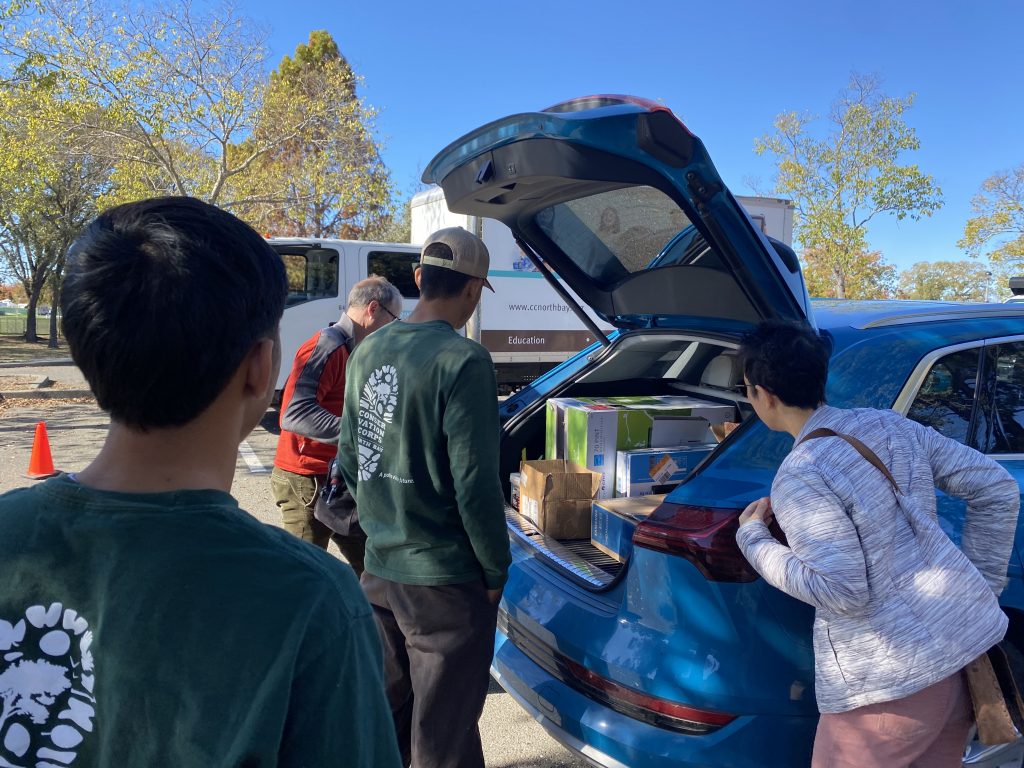
Cal Recycle, going back pretty far in CCNB’s history, has supported corpsmember and supervisor salaries and for vehicles to do collection work for those materials that we then send back out to companies that process the recycling. We don’t actually compact or break materials down here. Other companies do that after we’ve collected it. But what’s happened in the past couple of years, just because people are a little bit more savvy about recycling in the Bay Area, is that we’ve asked what else can be recycled and what can we do? The mattresses have been fairly new for us, as I mentioned before. So we work to keep bottles and cans, e-waste, tires and oil out of the waterways and the landfill. But now we’re also collecting mattresses, carpet for recycling, which we’re only doing in Cotati right now, and we’ve moved into the food waste sphere, too. Our e-waste number especially, seems to grow every single year. Because people just buy stuff and replace it so frequently. And a lot of those components can be broken down into different things. And a lot of the fine metals in there are actually pretty valuable. After working with Cal Recycle to collect the e-waste, other companies pay us for those materials because they can turn them into something else.
Why did you choose Conservation Corps?
Before being in the nonprofit sector, which I’ve been for nearly 12 years now, I worked for the local news agencies doing advertising, like the Marin IJ and the Press Democrat. So I switched careers midway. But my passion from the beginning has been helping young people get a good start. And having grown up here, really appreciating the environmental beauty of what’s here and wanting to protect it.
My career in the nonprofit sector has, for the most part, been involved in somehow helping young people. I used to work at Side By Side, which is a mental health organization for kids and youth in the Marin, Sonoma, and Alameda counties. I worked for a Yosemite Conservancy, raising money for the park, but it just felt like CCNB was a really good combination of helping young people accomplish their goals while really benefiting from the natural beauty of where we live. So it was just a perfect fit for me.
Do you have any funny stories from your time at CCNB?
There are plenty. There are lots of just small ones, but usually like wildlife. Our department sees almost every photo that’s taken for CCNB because we’re in charge of communications. And so we get, from all the crews that are out working, pictures of the work that they’re doing so that we can both share with folks like you and other organizations and with funders and the community about the work that we’re doing. And pretty frequently, we will get photos that involve animals. So whether someone has rescued a lizard or a salamander when they’re in the middle of something and they want to get it out of the way to this one, I think I’m not 100% sure, but I think this is in Santa Rosa at Taylor Mountain Regional Park, where we just did some trail work. It’s still recovering from the fires, but they had a roadblock of cows that they had to work around. Sometimes you have to do things on the cow’s time. So that was pretty funny.
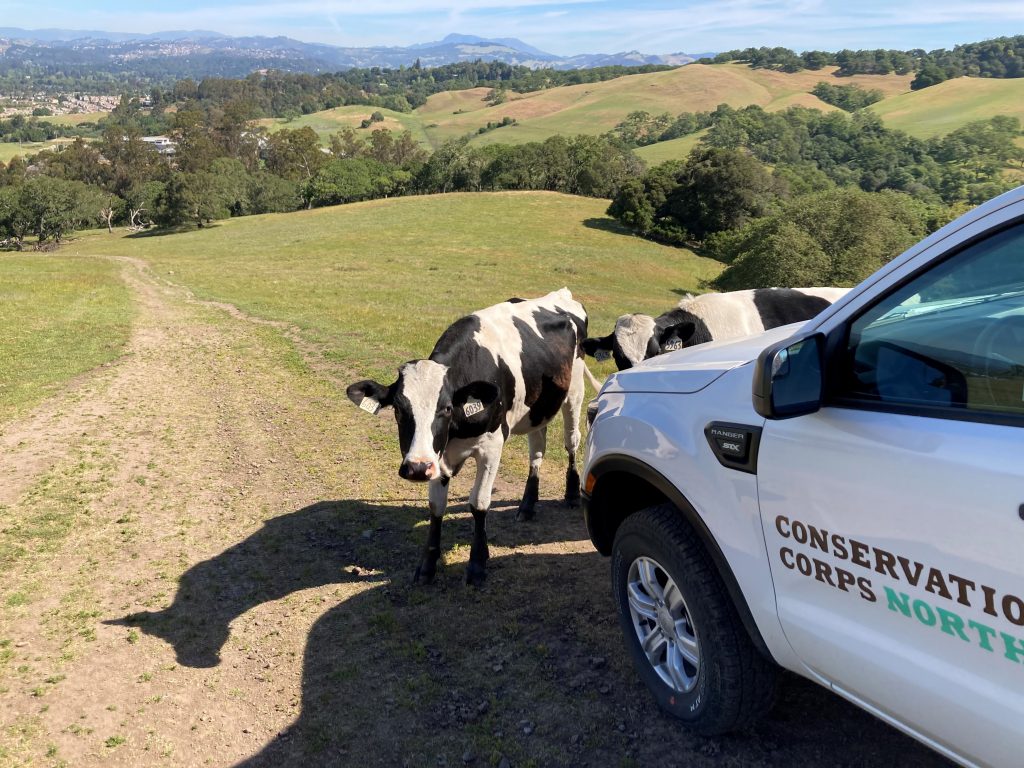
But really just the funny stories are all the joyful moments of the work that happens with the corpsmembers. There’s one pretty early on in the pandemic with one of our crews here in Marin. It was a rainy day. They had been out working all day. Exhausted, dirty, tired. But when they got back, they somehow got in their heads to do a Tik-Tok dance video. Just having staff get involved with corpsmembers and doing silly, joyful things outside of the day to day work, that can be really hard. It’s just one of the reasons that we’re here just to have that joy as well. So I wanted to share that with you. Thank you.
